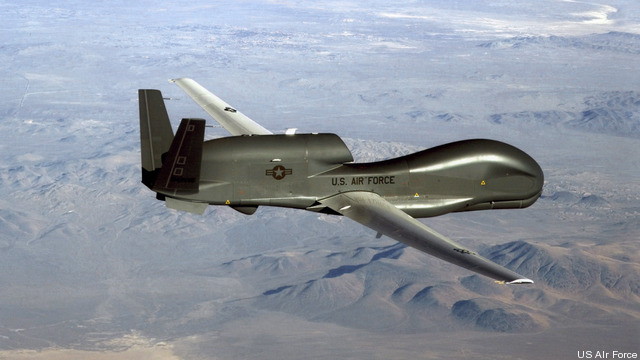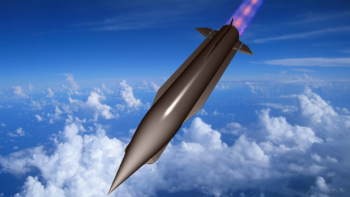
RQ-4 Global Hawk (USAF)
WASHINGTON: House authorizers, skeptical of the Air Force’s plan to divest a number of Intelligence, Surveillance and Reconnaissance (ISR) assets, are demanding that military commanders weigh in on the operational risks such a move would entail.
The mark up of the fiscal 2022 National Defense Authorization Act (NDAA) by the House Armed Services subcommittee on tactical aircraft and land forces, released Wednesday, also instructs the watchdog Government Accountability Office (GAO) to assess “current Air Force, Navy, and Marine Corps tactical aircraft capability and capacity requirements and forecasted shortfalls.”
The subcommittee will vote on the draft language crafted by Chairman Donald Norcross, D-NJ, and Ranking Member Vicky Hartzler, R-MO, on Thursday.
Airborne ISR Modernization
HASC’s concerns about airborne ISR modernization echo those voiced by Senate appropriators last week in a hearing on Defense Department plans for aircraft divestment. Lawmakers are deeply worried about whether retiring current ISR drones and manned aircraft will compromise the ability of field commanders to accomplish their missions in the near- and medium-term, and that there might even be gaps if future capabilities do not manifest as planned.
No one should be surprised by this — Congress last year slapped down a similar Air Force attempt to begin retiring parts of multiple ISR fleets, from the RQ-4 Global Hawk surveillance drones, made by Northrop Grumman, to the MQ-9 Reaper, made by General Atomics, to the elderly E-8 Joint Surveillance Radar and Attack System (JSTARS) aircraft.
The Air Force has nonetheless persisted with its argument that the retirements are needed in order to invest in future capabilities better able to withstand high-end conflict with China and Russia. The service’s fiscal 2022 budget request sought to get rid of 20 (out of a fleet of 21) Global Hawk Block 30s, and four of its 16 JSTARS.
It did not, however, ask to cut any of the beloved MQ-9 Reaper drones in the 2022 request; after Congress not only refused to allow the service to shut down the General Atomics production line in 2021 but also added 16 more to the Air Force’s planned buy. The service has been looking to replace the Reaper with a family of systems for multiple missions, but for the moment is keeping all 300 of its current fleet.
In testimony to the Senate Appropriations defense subcommittee on July 21, Lt. Gen. David Nahom, Air Force deputy chief of staff for plans and programs, admitted some risk with retiring the Block 30 Global Hawks, but insisted that the priority has to be on modernizing capabilities.
“That’s one of these places where you look at some near-term risk, to make sure we get to the fleet we want. There is some capacity that they provide to the the joint users, the combatant commands out there, that we will have to mitigate with other technologies,” he said.
However, Nahom explained, for the future “the three things that are most important is an ISR platform that can survive in the threat, persist in the threat, and then be connected.” The Global Hawk, he said, “was not designed with the threat we’re looking at right now from a resurgent China.”
But the more advanced Block 40 Global Hawks are still needed to provide ground moving target indication (GMTI), as are a number of the JSTARS which provide the same type of data “despite really showing their age,” Nahom noted.
He refused to discuss the exact plans for next-generation airborne ISR capabilities in the unclassified portion of the SAC-D hearing, except to say a “family of systems” is in the works. He also indicated that new capabilities would be coming on board in the next six to eight years that would allow further divestment of current aircraft.
The discussion around Global Hawk’s future comes as Gen. Jay Raymond, head of the Space Force, has made a bid to transfer the GMTI mission into his portfolio, and in the early stages of developing a demonstration satellite — a move that is somewhat controversial because of the overlap with the mission of the NRO.

The MQ-9 Reaper continues to survive in the budget. (DoD)
In addition, one of the earliest goals of the Air Force’s top-priority Advanced Battle Management System (ABMS) was to replace the JSTARS and the 1970s-era Boeing E-3 Sentry Airborne Warning and Control System (AWACS) planes with a modern, hyper-connected suite of capabilities.
The HASC markup instructs the geographic combatant commands (interestingly, with the exception of Space Command) to provide a risk assessment of the Air Force ISR modernization plans “to meet near-, mid-, and far-term contingency and steady-state operational requirements against adversaries in support of the objectives of the 2018 national defense strategy.” The reports are due March 31, 2022.
The results are unlikely to support the Air Force’s retirement hopes. Combatant Commanders, when testifying in front of Congress, always repeat the same line: that if they could magically have more of something, it would be ISR capabilities.
TacAir Gaps?
“Despite billions of dollars of investment in developing and acquiring tactical fighter aircraft over many years, the Air Force, Navy, and Marine Corps will likely continue to face capability and capacity shortfalls over the upcoming decades,” the HASC subcommittee report states.
Lawmakers went on to throw shade at the services for not heeding long-standing warnings about upcoming shortfalls, starting with a 2010 GAO report. “The committee notes that the tactical fighter aircraft shortfalls facing the military services did not suddenly appear,” the report states wryly.
Thus, the mark up directs GAO to submit a new report to Congress “that assesses and identifies current Air Force, Navy, and Marine Corps tactical aircraft capability and capacity requirements and forecasted shortfalls.” The review also must include a look at “the extent to which the services’ tactical aircraft acquisition and modernization investment plans” — including the Air Force and Navy efforts under the Next-Generation Air Dominance (NGAD) program — “are likely to meet those requirements and address the shortfalls.” The report is due April 1, 2022.
As with ISR aircraft, lawmakers on both sides of Capitol Hill have been leery of Air Force plans to downsize from its current seven different tactical aircraft fleets to “four plus one”: NGAD, which is envisioned as a family of systems; Boeing’s F-15EX Eagle II; Lockheed Martin’s (troubled) F-35A; the venerable Lockheed Martin F-16, and eventually a replacement that represents a half-way point between the F-16’s capabilities and those of a fifth-generation fighter; and the (seemingly immortal) A-10 Warthog ground attack plane.
In particular, there has been long-standing lawmaker concern that NGAD will not produce tangible results in time to avoid a capabilities gap.
UK picks 90 suppliers to support Hypersonic strike program
The various suppliers were all picked to join a Hypersonic Technologies and Capability Development Framework (HTCDF) agreement, making them eligible to compete for eight lots worth a maximum value of £1 billion ($1.3 billion) over the next seven years.


























